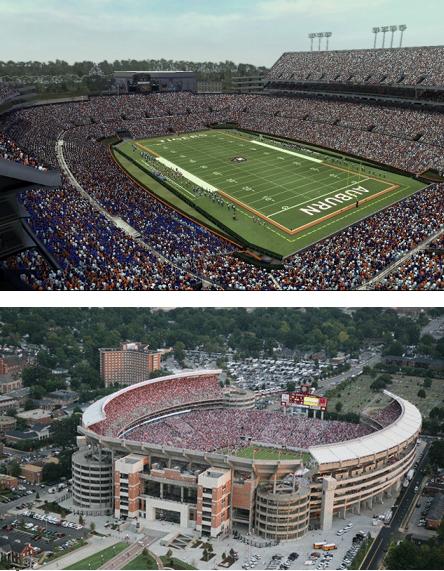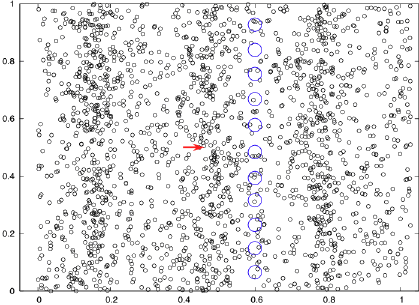Sound in football stadiums
The home-field advantage in college football depends a lot on crowd noise. When the opposing offense is on the field in very loud stadiums like Jordan-Hare or Bryant-Denny, the crowd makes it difficult for the players to communicate on the field. Let’s talk about the physics of sound waves (an atmospheric wave) and just how much difference there is to the players in a stadium with 102,000 people (Alabama), 87,000 people (Auburn), or 62,000 (Ole Miss). Assume the visitors get 10,000 seats.
Sound is a wave of pressure in the atmosphere. Something vibrates (in this case, people’s vocal cords), and it creates positive and negative pressure in the air around it. This pressure oscillation moves as a sound wave away from the person, as shown below. The sound source is at the right end, and the air molecules oscillate at the frequency of the sound. If you follow any one air molecule, it never moves in total, but the waves do. This is similar to other waves…they transmit energy, not mass. The size of the blue circle indicates the sound pressure at that location.
Sound is measured in decibels, and here is where it gets interesting. The actual loudness in decibels is a logarithm of the sound pressure, or power of 10. So, to increase the sound by 10 dB, you have to multiply the input sound pressure by a factor of 10, in other words, 40 dB is 100 times louder than 20 dB, not just twice as loud. Also, sound spreads out from where a person yells, and the pressure gets attenuated (reduced), roughly as the surface area of the sphere of the person’s voice print expands, or 1/(distance from person squared). (We are not taking into account the complicated stuff like viscosity, for that see Navier-Stokes equations).
OK. If each person yells about as loud as they can, that produces about 130 dB at 8 feet, or a pressure of 0.63 mb (atmospheric pressure is about 1000 mb). If the average distance from that person to the offense on the field is 50 yards (150 feet), then the pressure from each person’s voice is reduced to 0.0018 mb. So, one person yelling doesn’t do much. But, if you multiply that number by the number of home crowd, you get the total sound pressure at the offense.
Ole Miss: 0.93 mb (133.3 dB)
Auburn: 1.38 mb (136.7 dB)
Alabama: 1.64 mb (138.3 dB)
So, the actual size of the crowd does not make quite as much difference as one might think, because of the logarithm. Still, we all know Jordan-Hare is louder than Vaught-Hemingway, and although my first visit to Alabama’s newly-enlarged Bryant-Denny will be this Friday, it should be louder than Jordan-Hare.
The biggest thing is distance from the people yelling. If you’re way up in the upper deck, your yelling doesn’t do much. Same if you’re on the opposite end of the field of the players. This is why driving into the student section of the opposing team is so difficult…they yell the loudest, and are usually in seats close to the field.
Category: Met 101/Weather History





















Comments (1)
Trackback URL | Comments RSS Feed
Sites That Link to this Post